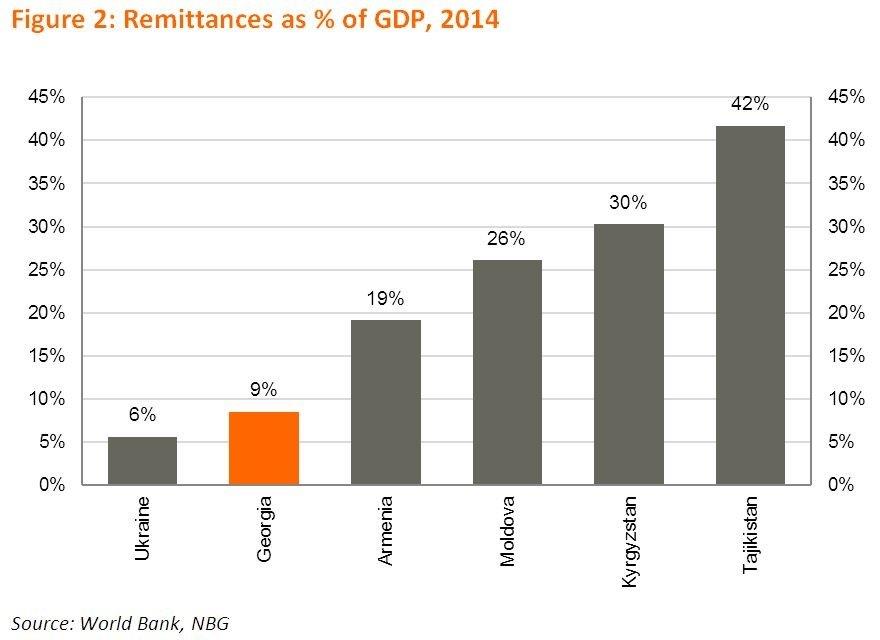Remittances - Trends and Implications
Workers remittances have significant social and economic implications for Georgia. They represent a major source of foreign currency inflows, and have increased six-fold to US$ 1.4 billion in 2014 from US$ 230 million in 2004, while their share to GDP has averaged 7%. Notably, remittances have expanded not only from traditional donor countries over 2004-2014, but also increasingly from countries that accounted for little or no inflows in 2004, such as Israel, Ireland, Iraq, Belarus, and China. However, increasing remittances are also a sign of poor employment prospects and socioeconomic difficulties in Georgia, pushing Georgian workers to overseas employment. It is noteworthy that a majority of Georgian emigrants are employed in Russia, which has traditionally accounted for half of total remittances. Consequently, the ongoing economic slowdown in Russia, along with the depreciation of the ruble, has negatively affected money inflows from Russia, which shrank 41.1% y/y in 1H15. Russia’s share has fallen to 38% of total remittances and we expect no improvement in the short term.
In 1H15, remittances to Georgia have fallen from other major contributors like Greece and Italy, decreasing 19.4% y/y (US$ 20 million loss) and 12.4% y/y (US$ 7.5 million loss), respectively. The decreases can be attributed not only to economic troubles in those countries but to the lower remittance value in USD terms due to the weaker Euro. As ongoing economic troubles in Greece are unlikely to subside in the near term, it is likely that Georgian emigrants will move to other countries for employment, while relatively few might return to Georgia. On the other hand, in 1H15 inflows increased robustly from USA (+26.4% y/y), Turkey (+20.6% y/y) and Israel (+37.4% y/y), accounting for 18.1% of total, which partially offset the decline of inflows from aforementioned traditional donors. As a result, remittances in 1H15 fell 22.8% y/y. Given the current trend, we expect remittances to decline by 18-20% y/y in 2015.

Remittances are even more significant for other regional economies. They represent almost half of Tajikistan’s GDP, around 20% of GDP in Armenia, more than 25% of GDP in Moldova, and around 30% of GDP in Kyrgyzstan. Notably, in these countries, as well as in Georgia, money sent from emigrants employed in Russia comprises a significant portion of total inflows.

A decrease in remittances has several economic consequences for Georgia. First, declining money inflows was one of the contributors to lari depreciation, along with lower exports at the end of 2014 and beginning of 2015. However, the depreciation has helped the domestic currency value of remittances and expenditures, minimizing the effect on nominal GDP. Secondly, lower remittances mean lower consumption and investment component of remittances (as part of the flows goes to purchase real estate). Notably, private consumption increased 4.1% y/y in 1Q15 and there was little sign of imports adjusting to lower remittances in the beginning of 2015. However, starting from April we see significant import adjustment, which should limit the net impact on the current account stemming from lower remittances. At the same time, operations in real estate increased 5.2% y/y in real terms in 1Q15 and property registration continued growing in 2Q15 as well.
To sum up, remittances are an important source of consumption, investment and hard currency inflows; however, they create vulnerabilities in recipient countries when economic conditions are unfavorable in remitting countries. Georgia has no control over the external environment or its emigrants’ employment prospects, but it is capable of stimulating domestic economic activity and creating decent living conditions for its population. Enhanced economic prospects are essential for would-be emigrants to pursue employment opportunities within the country, positively affecting Georgia’s potential GDP. Therefore, policymakers have to be supportive of the business environment, implementing policies aimed at developing small and medium businesses and placing greater emphasis on employment generating sectors.
David Kutidze (Galt and Taggart)











